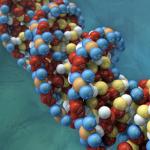27 October 2010
An international effort to build a detailed map of human genetic variation has completed its pilot phase and could shape a new understanding of human evolution and may help in fighting disease.

Getty Images/iStockphoto
The 1000 Genomes Project aims to sequence the genetic code of 2,500 people.A decade ago, scientists made worldwide headlines when they announced they had sequenced the human genome - made a kind of map, in other words, of DNA, the inherited molecule that makes us human. But that was only one genome. Everyone on Earth has a unique genetic makeup, and researchers have now sequenced thousands of individuals' DNA.
The first effort to sequence the human genome came in under budget and ahead of schedule, and the process has gotten progressively cheaper and faster.
"In the last 10 years," said Richard Durbin, co-chair of the 1000 Genomes Project. "DNA sequencing technology has advanced dramatically so it has become feasible to systematically sequence many people to find genetic variants, and build a catalog which we can use as a basis for investigations into disease, genetics, and which variants may be functional."

Getty Images/iStockphoto
Genetic variations are the way your genes differ from other people's. Some variations relate to differences we can see, like eye color. Others may put us at greater risk for disease. Some variations are inherited. Others can be caused by toxic chemicals or radiation or simply by mistakes in copying DNA.
Most genetic variations are found in lots of unrelated people. Scientists have started to investigate possible links between disease and some of these variations, called single nucleotide polymorphisms, or SNPs. The researchers aim to probe deeper.
"The 1000 Genomes Project makes this approach much more complete and much more powerful," said David Altschuler, 1000 Genomes co-chair, "by going down to much lower frequencies, and also broader range of populations and more complete data in each frequency range and each population."
At the University of Washington in Seattle, meanwhile, Evan Eichler and his colleagues have been using a technique to identify pieces of the genome that duplicate other parts of the DNA code. Writing in the journal Science, the researchers describe how they identified more than four million places where they found these duplicates, called copy-number variants.
Eichler says these variants could help identify genes that may be associated with disease that are what he called "inaccessible" using other techniques. He also said it can help improve the understanding of human evolution.
"We think the veil has been lifted for us in terms of a whole new level of genetic diversity. And when we compare these roughly 159 humans that we've analyzed to date, and compared variations they've found in their genomes to that of the great apes, we have the ability, I think pretty clearly, to identify the genes and the gene families which have expanded specifically in our lineage of evolution since we separated from that of chimpanzee and gorilla," Eichler said.
Back at the 1000 Genomes project, co-chair David Altshuler says the organization's work will provide data so scientists can answer questions about the role genes play in health based on facts, not guesswork. "And so rather than speculate," he said, "I think we'd say we are helping to create the foundation to answer that question, and anyone who does speculate, I think is speculating."
By the way, the goal of the 1000 Genomes project isn't to sequence the genetic code of exactly 1,000 people. Instead, the aim is to identify genetic variations that occur in at least one out of every 100 people or one percent. In particular, that will require using genetic material from many thousands of people from all over the world. And it will need to include a lot more geographic diversity. Only a handful of genomes from Latin America and Africa have been sequenced so far.